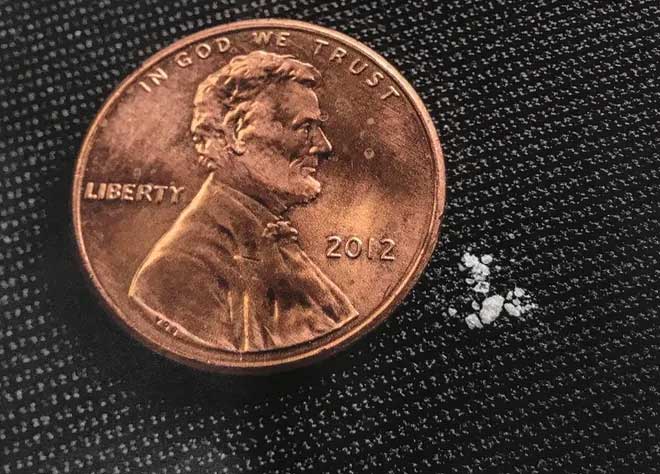What Does One Milligram Of Powder Substance Look Like?

Medically Reviewed By: Manish Mishra, MBBS
Many Ohio residents use powder substances such as cocaine, heroin, and methamphetamine. These drugs are available in various doses, including one milligram. One milligram of powder substance typically resembles a grain of sand.

Illicit drugs come in many dosage forms, including powders. Some of the most popular powder substances include cocaine, fentanyl, heroin, methamphetamine, and MDMA. These controlled substances are available in various doses, including one milligram.
What Does One Milligram Of Powder Substance Look Like?
One milligram of powder substance typically resembles a grain of sand. To determine if it’s exactly one milligram, you would need to use a milligram scale.
The color of the grain-sized powder will depend on the drug.

Cocaine
Cocaine is a stimulant drug made from the leaves of the coca plant. The powder form of cocaine, cocaine hydrochloride, is made with coca paste and sodium chloride (salt).
Cocaine powder generally ranges from white to off-white. However, much of the cocaine sold in Ohio contains additives that affect the color. In particular, additives like caffeine and procaine can turn the drug beige.
Fentanyl
Fentanyl is a synthetic opioid analgesic (painkiller) that was developed as an intravenous anesthetic.
While pure fentanyl powder is white, additives can turn it beige or brown. Also, according to the Drug Enforcement Administration (DEA), some drug dealers have recently started selling “rainbow fentanyl,” which comes in various bright colors.
Heroin
Heroin is a semi-synthetic opioid made from a natural opioid called morphine sulfate. The powder form ranges from white to brown. As with cocaine and fentanyl, additives make heroin darker.
Methamphetamine
Methamphetamine (or “meth”) is a stimulant drug made from a variety of ingredients, including dangerous chemicals (such as anhydrous ammonia) and over-the-counter medications and supplements (such as pseudoephedrine).
The powder form of meth ranges from white to off-white. However, certain meth ingredients can change the drug’s color in some cases. For example, solvents like camping stove fuel may turn the powder blue, while red pseudoephedrine may turn it pink or red.
MDMA
MDMA is a synthetic drug that acts as both a stimulant and a psychedelic. The powder formulation of MDMA is often called “molly.” It typically ranges from white to yellow.
Dangers Of Powder Substances
No matter the dose range, powder substances pose serious health risks.
Cocaine
According to the National Institute on Drug Abuse, cocaine poses many short-term health risks, including:
- constricted blood vessels
- increased heart rate, blood pressure, and body temperature
- shaking
- anxiety
- paranoia
- irritability
- aggression and violence
In addition, regular cocaine use can lead to addiction, heart attack, and stroke.
Fentanyl
Fentanyl is among the most dangerous drugs in the world. According to the Centers for Disease Control and Prevention (CDC), it’s up to 50 times stronger than heroin and 100 times stronger than morphine.
Even two milligrams (the size of about two grains of sand) can cause a life-threatening opioid overdose.
Other possible side effects of fentanyl include drowsiness, nausea, and urinary retention. The drug is also highly addictive.
Heroin
The most common side effects of heroin include:
- drowsiness
- sedation
- nausea and vomiting
- severe itching
- slow breathing
- slow heart rate
Heroin also poses a high risk of overdose and addiction. Heroin addiction makes you more likely to develop other health problems, including liver disease, kidney disease, and HIV.
Methamphetamine
People who use methamphetamine face a variety of short-term health risks, including:
- increased blood pressure
- rapid or irregular heartbeat
- loss of appetite
- trouble sleeping
- nausea
- irritability or aggression
Meth can also cause psychotic symptoms, such as paranoia, hallucinations, and delusions.
In addition, it’s highly addictive. Meth addiction can lead to serious health problems, including brain damage, lung damage, and heart attack.
MDMA
Regular MDMA use can cause issues like depression, trouble concentrating, and heart disease.
Also, while researchers haven’t determined if MDMA is addictive, it can cause symptoms of addiction, including:
- frequent cravings
- tolerance (needing increasingly higher doses of MDMA to feel the drug’s effects)
- physical dependence (experiencing withdrawal symptoms, such as anxiety and fatigue, when you don’t use MDMA)
Powder Substance Addiction Treatment Options
If you feel unable to stop using a powder substance, seek medical advice right away. You may need to attend an addiction treatment program. Addiction treatment Centers in Ohio offer services such as:
- medical detox, in which doctors help you slowly and safely become drug-free
- mental health counseling, in which a therapist will help you manage cravings and any mental health concerns that may have contributed to your drug use
- support groups, in which you can discuss your experiences with other people in recovery
- medication-assisted treatment, in which doctors prescribe medications such as methadone and buprenorphine to treat certain types of addiction
To learn more about addiction treatment options, please reach out to Ohio Recovery Center. Our substance abuse treatment programs offer personalized, evidence-based care to help you or your loved one stay sober.
- Centers for Disease Control and Prevention — Fentanyl Facts https://www.cdc.gov/stopoverdose/fentanyl/index.html
- Drug Enforcement Administration — DEA Warns of Brightly-Colored Fentanyl Used to Target Young Americans https://www.dea.gov/press-releases/2022/08/30/dea-warns-brightly-colored-fentanyl-used-target-young-americans
- National Institute on Drug Abuse — What are the effects of MDMA? https://nida.nih.gov/publications/research-reports/mdma-ecstasy-abuse/what-are-effects-mdma
- National Library of Medicine: MedlinePlus — Heroin https://medlineplus.gov/heroin.html
- Substance Abuse and Mental Health Services Administration — Know the Risks of Meth https://www.samhsa.gov/meth

